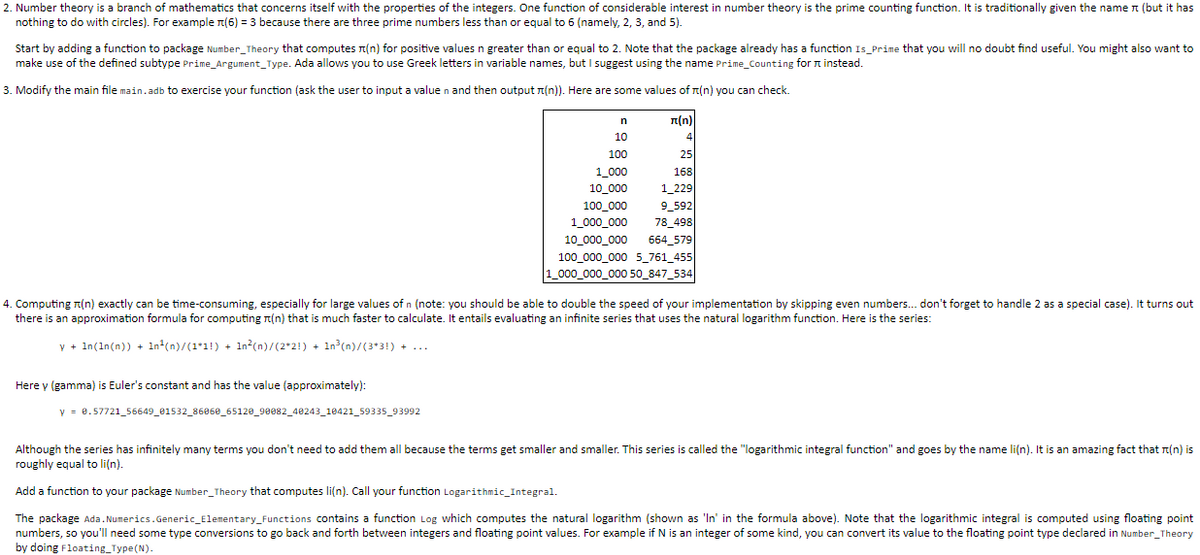Theory.adb
This code is in Ada code in Ada Please
Not in C code
Please type your solution out in working code don't just give me an example they may just confuse me more
Below is Number_Theory.adb
with Ada.Numerics.Generic_Elementary_Functions;
package body Number_Theory is
-- Instantiate the library for floating point math using Floating_Type.
package Floating_Functions is new Ada.Numerics.Generic_Elementary_Functions(Floating_Type);
use Floating_Functions;
function Factorial(N : in Factorial_Argument_Type) return Positive is
begin
-- TODO: Finish me!
--
-- 0! is 1
-- N! is N * (N-1) * (N-2) * ... * 1
return 1;
end Factorial;
function Is_Prime(N : in Prime_Argument_Type) return Boolean is
Upper_Bound : Prime_Argument_Type;
Current_Divisor : Prime_Argument_Type;
begin
-- Handle 2 as a special case.
if N = 2 then
return True;
end if;
Upper_Bound := N - 1;
Current_Divisor := 2;
while Current_Divisor < Upper_Bound loop
if N rem Current_Divisor = 0 then
return False;
end if;
Upper_Bound := N / Current_Divisor;
end loop;
return True;
end Is_Prime;
function Prime_Counting(N : in Prime_Argument_Type) return Natural is
begin
-- TODO: Finish me!
--
-- See the lab page for more information.
return 0;
end Prime_Counting;
function Logarithmic_Integral(N : in Prime_Argument_Type) return Floating_Type is
begin
-- TODO: Finish me!
--
-- See the lab page for more information.
return 1.0;
end Logarithmic_Integral;
end Number_Theory;
Below is Number_Theory.ads
-- This package contains subprograms for doing number theoretic computations.
-- It is used in VTC's CIS-2730, Lab #2.
package Number_Theory is
-- Constant Definitions
-----------------------
Gamma : constant := 0.57721_56649_01532_86060_65120_90082_40243_10421_59335_93992;
-- Type Definitions
-------------------
-- The range of values for which N! can be computed without overflow.
subtype Factorial_Argument_Type is Integer range 0 .. 12;
-- The range of values that might meaningfully be asked: are you prime?
subtype Prime_Argument_Type is Integer range 2 .. Integer'Last;
-- A floating point type with at least 15 significant decimal digits.
type Floating_Type is digits 15;
-- Subprogram Declarations
--------------------------
-- Returns N!
function Factorial(N : Factorial_Argument_Type) return Positive;
-- Returns True if N is prime; False otherwise.
function Is_Prime(N : in Prime_Argument_Type) return Boolean;
-- Returns the number of prime numbers less than or equal to N.
function Prime_Counting(N : in Prime_Argument_Type) return Natural;
-- The logarithmic integral function, which is an approximation of the prime counting function.
function Logarithmic_Integral(N : in Prime_Argument_Type) return Floating_Type;
end Number_Theory;
Below in main.adb
-- This main program is used in VTC's CIS-2730, Lab #2.
-- Some packages that we will need.
with Ada.Text_IO;
with Ada.Integer_Text_IO;
with Number_Theory;
-- Make the contents of the standard library packages "directly visible."
use Ada.Text_IO;
use Ada.Integer_Text_IO;
procedure Main is
-- We need to print values of type Number_Theory.Floating_Type, so generate a package for that.
package Floating_IO is new Ada.Text_IO.Float_IO(Number_Theory.Floating_Type);
use Floating_IO;
N : Number_Theory.Prime_Argument_Type;
-- Add any other local variables you might need here.
begin
Put_Line("Counting Primes!");
-- TODO: Finish me!
end Main;

Step by step
Solved in 2 steps


